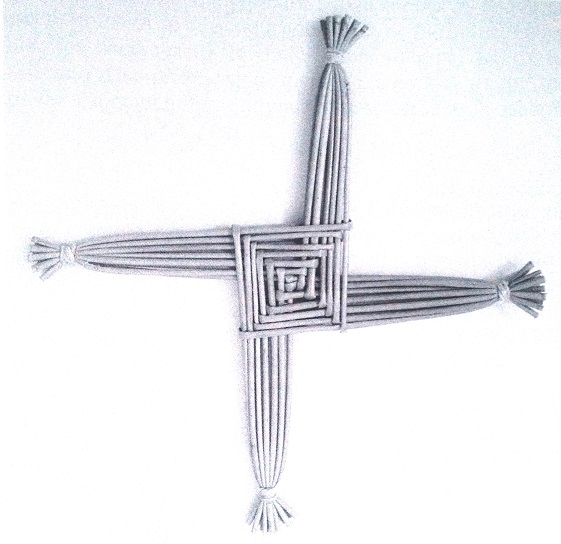 The first of February is celebrated in Ireland as St Brigid’s day, a date originally associated with the pre-Christian festival known as Imbolc, which marked the start of Spring. Brigid is one of the patron saints of Ireland with Patrick and Columba. Many miracles were attributed to her. From early Christian times, it became traditional for each family to make and display a Saint Brigid’s Cross, a small cross made with rushes. Straw and small sally rods were also used to make Saint Brigid’s crosses and there were a number of different designs. The origin of the tradition is said to have begun when a local chieftain in Kildare was ill and Brigid went to see him. She soon realised that he was dying and decided to speak to him about Christianity. While doing so, she picked up rushes from the floor of the house and knitted them into a cross. He asked her what she was doing. She placed the cross in his hands and explained to him about Jesus, his crucifixion and resurrection. When told of its symbolism, the dying person asked to be baptised. Shortly after his baptism, he died. Afterwards Saint Brigid came to be associated with hope, renewal and growth. In Ireland it was traditional to place a Saint Brigid’s Cross over a doorway in the belief that it protected a house from fire and saved its inhabitants from any harm. Saint Brigid’s Cross became one of the symbols of Ireland with the harp and shamrock. Today the custom is kept alive in Ireland, especially with primary schools playing big roles in observance of this custom. It is still customary to see a Saint Brigid’s Cross in many homes. When RTÉ television started broadcasting in 1960, it selected Saint Brigid’s Cross as its emblem until the 1990s. According to Irish folklore, some prayers once invoked Saint Brigid and a brat. The brat was a piece of cloth left outside a house on the eve of the feast. It was believed that the saint travelled around the country during the night and touched the cloth, endowing it with healing powers. It was believed that the brat was effective in healing various pains, and many going on special journeys regularly wore it. It is believed that Brigid (c. 451-524) was born in Faughart, about 3km north of Dundalk, in County Louth, where there is now a Saint Brigid stone and pillar as well as holy well. It is still a place of pilgrimage. After becoming a nun, Brigid founded a number of monasteries, especially one in Kildare where she spent a big part of her life. Before the introduction of Christianity to Ireland the people had a tradition of worshiping at pagan sites, where they performed various rituals. They also believed that some wells had healing power. When Brigid came to Kildare around 480, she is believed to have started her foundation on the site of an older pagan shrine to a Celtic goddess of the same name. Accompanied by a group of seven companions, Brigid is said to have established the first community of women dedicated to religious life in Ireland at Kildare. She is said to have founded two communities there, one for women and the other for men. Kildare developed into an important monastic foundation in early Christian times. It is believed that Saint Brigid died in Kildare. Many place names in Ireland are called Kilbride, the church of Brigid, in her memory. Bernard O'Hara's latest book entitled Killasser: Heritage of a Mayo Parish is now on sale in the USA and UK as a paperback book at amazon.com, amazon.co.uk or Barnes and Noble It is also available as an eBook from the Apple iBookstore (for reading on iPad and iPhone), from Amazon.com and Amazon.co.uk (Kindle & Kindle Fire) and from Barnesandnoble.com (Nook tablet and eReader). An earlier publication, a concise biography of Michael Davitt, entitled Davitt by Bernard O’Hara published in 2006 by Mayo County Council , is now available as Davitt: Irish Patriot and Father of the Land League by Bernard O’Hara, which was published in the USA by Tudor Gate Press (www.tudorgatepress.com) and is available from amazon.com and amazon.co.uk. It can be obtained as an eBook from the Apple iBookstore (for reading on iPad and iPhone), from Amazon.com and Amazon.co.uk (Kindle & Kindle Fire) and from Barnesandnoble.com (Nook tablet and eReader). |